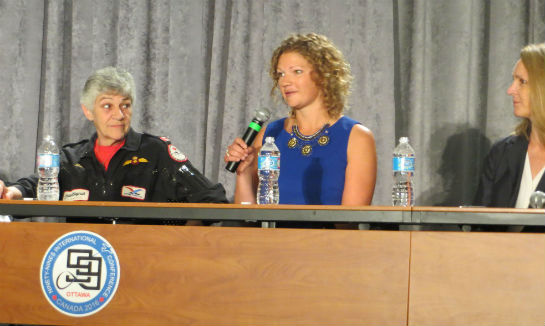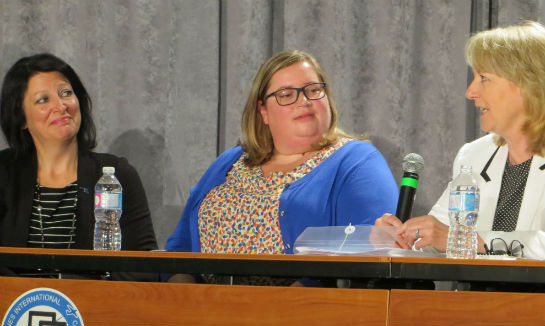Why, well into the 21st century, is the proportion of women in commercial aviation still stuck in the single digits? In Canada, it’s about six per cent and is probably even smaller globally. The Air Line Pilots Association, which has 53,000 members employed by 31 carriers in the United States and Canada, told Skies that approximately five per cent of its members are women.
From left to right are Dee Brasseur, Emily Crombez and Lynne McMullen. The three were part of a panel of accomplished female aviation professionals who spoke at the Ninety-Nines recent international conference in Ottawa. 99s Photo
The simple answer is that it’s the legacy of a society which has been male-dominated for millennia. Then, there’s the cost of certifications needed to fly commercially, starting with approximately $10,000 for a basic private pilot licence and rapidly ramping up from there by a factor of four or more.
Aspiring aviators can cover most of it by learning to fly in the military, and many who do so go on to fly commercially. However, there are still relatively few women pilots in military ranks.
While 18.7 per cent of Royal Canadian Air Force personnel overall are women, just under five per cent of its pilots at the end of July were women; they included 74 or 5.2 per cent of 1,436 Regular Force pilots and seven or 3.7 per cent of 190 in the Reserves. In the U.S. Air Force, 682 women pilots accounted for 5.3 per cent of 12,802 total pilots on active duty last March. In both cases, women are also found elsewhere in air operations, including maintenance, communications and other roles.
The Ninety-Nines Inc. International Organization of Women Pilots has been trying to rectify this imbalance since November 1929, when aviation pioneer Amelia Earhart and 98 others became charter members, with Earhart as its first president. As the first woman to fly across the Atlantic, in June 1928, she once said that her ambition was to eventually “produce practical results for the future of commercial flying and for the women who may want to fly tomorrow’s planes.”
Today, the not-for-profit charitable organization, appropriately headquartered on Amelia Earhart Drive at Will Rogers Airport in Oklahoma City, provides scholarships and other support for women. As of late July, it had 4,846 pilot members worldwide, comprising 4,326 in the U.S. and 214 in Canada, with the other 306 scattered among dozens of other countries.
This summer, the 99s’ annual conference was held in Ottawa, followed by a rally to Michel-Pouliot Gaspé Airport in Quebec and a touch-and-go competition at Rockcliffe Flying Club (RFC). The conference attracted several hundred pilots, mostly from North America but some from Australia, Germany, Iran, Jordan and New Zealand.
It gave Skies an opportunity to explore the gender issue anecdotally with a number of attendees, including several from Toronto-based Porter Airlines, where some 12 per cent of its 250 pilots are women.
Accompanied by smiles and occasional shrugs, their responses boiled down to, “It’s been a man’s world so far, but we’re getting a foothold.” All were clearly happy to be flying, often with an all-female crew and mostly short-haul services. Like their male counterparts within Porter and elsewhere, they likely aspire to step up to major carriers and longer-hauls.
The Limitless Sky seminar included (l-r) Maryse Carmichael, Lyndsay Poynter and Mary Ellen Pauli. 99s Photo
Porter President Robert Deluce agrees that women are “generally underrepresented” in aviation overall. “There needs to be a fundamental shift in thinking,” he said on International Women’s Day this year. “Being a pilot or maintenance engineer or executive is a job for anyone willing to work hard and with a passion for what they do.”
As the 99s conference showed—especially a “Limitless Sky” panel moderated by helicopter pilot and pioneer Toronto traffic reporter Dini Petty, who logged 5,000 hours before turning her talents to Canada’s longest-running television talk show through the 1990s—there’s no shortage of passion.
Joy Parker Blackwood of Stouffville, Ont., a long-time 99s member who organized the Ottawa conference, agreed that “it all starts with passion, followed by dedication and hard work.” She told Skies that elements of the panel discussion would become an online resource for elementary and high school students (see link at the end of this article).
Another important aspect of the conference, she added, was the “significant sponsorship and participation of aviation corporations,” a new aspect of 99s events. They included Porter, CAE Inc., Jazz Aviation, Air Canada, WestJet, Georgian Bay Airways, and Seneca and Confederation colleges.
“All these organizations recognize the value of . . . women in the industry,” continued Parker Blackwood. “It was an opportunity for them to have a better understanding of who the 99s are and what they do, and an opportunity for the 99s to build relationships.”
As for the panel, she said that it would help “to inspire and mentor the younger, new 99s members who are building their careers or certifications.”
Sharing stories of challenges overcome in a male-dominated industry, the panellists, alphabetically by surname, were:
• Rosella Bjornson, first female airline pilot in Canada, flying Fokker 28s for Transair in 1973 and eventually winding up as the first female captain on Air Canada 737s in 1990;
• Maj (Ret.) Deanna Brasseur, first female pilot on the Royal Canadian Air Force CF-188 Hornet, in 1989;
• LCol (Ret.) Maryse Carmichael, first female commander of RCAF 431 Air Demonstration Squadron, the Snowbirds;
• Emily Crombez, first female Bombardier 415 waterbomber pilot in North America;
• Lynne McMullen, a Transport Canada licensed pilot examiner and first female chair of the Seneca College School of Aviation;
• Mary Ellen Pauli, a resource and wildlife management helicopter pilot with the Ontario Ministry of Natural Resources and Forestry; and
• Lyndsey Poynter, project engineer at MacDonald Dettwiler and Associates Ltd. on the Canadarm2 and Dextre robotic arms on the International Space Station and section lead for training astronauts and ground controllers.
The panel was rounded out by Kathy Fox, chair of the Transportation Safety Board of Canada (TSB) since 2014 and, before that, the first female vice-president of operations at Nav Canada. Fox was also the first female president, at the age of 20, of the 5,000-member Canadian Sport Parachuting Association, where she logged 648 jumps and led Canadian teams to two international competitions before earning enough to fulfil her lifelong dream of being a pilot.
Holding multiple ratings and maintaining her flight instructor currency as a volunteer instructor “roughly one day a week” at RFC, Fox was inducted into Canada’s Aviation Hall of Fame in June. She told her audience that she had taken up skydiving as a teenager “because I figured that was a way of getting up in the air.” Then she joked that “once I learned how to fly and land the airplane, I quit jumping out of them!” When the laughter subsided, she added that when she found that she wouldn’t be able to fly commercially, “I became an air traffic controller so I could tell pilots where to go!”
Fox sat down with Skies to chat about the media fuss that occurs each time there’s news of all-female commercial crews, like those who flew an Air India Boeing 777LR from Delhi to San Francisco and back last March. A week later, an all-female Royal Brunei Airlines crew flew a Boeing 787 Dreamliner from Brunei to Jeddah, Saudi Arabia, where, ironically, ultraconservative clerics still prevent women from driving automobiles!
Recently, during a stopover in Frankfurt, Skies overheard a nearby male passenger commenting about a crewmember walking toward the gate. “Wow, that’s a peculiar uniform for a stew,” he said, only to blush when told by a friend that the rings on the crewmember’s sleeve indicated that she was the pilot on that flight.
Fox agreed that shouldn’t be unusual but acknowledged that women pilots, especially all-women crews, remain “a relative rarity.” She suggested that it flows from young girls’ lack of exposure to the reality that women can do any job they want to. “But if they don’t know the path to those jobs, they may limit themselves in terms of what opportunities they think are available.”
As a youngster, Transportation Safety Board Chair Kathy Fox dreamed of becoming, among other things, a fighter pilot. In May 2007, the RCAF offered her a CF-188 Hornet ride out of Bagotville, Que., and she actually had the controls for a short while. DND Photo
In addition to the 99s programs, Fox is enthusiastic about the Institute for Women Of Aviation Worldwide which, around International Women’s Day in each March, gets girls and young women up in aircraft so they can experience the joys of aviation through free rides. “It initiates them early to the notion that women can be pilots.”
She also pointed out there are many other job opportunities for women in aviation, be it maintainers, technicians, air traffic controllers or management. “It’s about exposure early on and then having role models.”
Having received the 99s Award of Inspiration at the recent gathering, Fox demurred at being described as “a poster child” for women in aviation.
Instead, she lauded the Northern Lights Award Foundation “for highlighting the number of women who are doing really interesting things . . . and giving visibility to them.”
Conceived by long-time 99s member Anna Pangrazzi, owner of Apex Aircraft Sales Ltd. in Markham, Ont., the Northern Lights awards, given annually each October, recognize recipients’ significant contribution to aviation and/or aerospace in Canada. There were seven recipients in various categories last year.
Fox concluded that if more women are exposed at an early age to aviation career opportunities, lingering systemic barriers can be dismantled. “If attitudes change, there will be more women gravitating to aviation. But, again, it has to be encouraged.”
Earhart, whose Lockheed Electra disappeared during a transpacific crossing attempt in July 1937, undoubtedly would have agreed. “Women must try to do other things as men have tried,” she explained in a letter to her husband. “When they fail, their failure must be but a challenge to others.”
To view the Limitless Sky simulcast from the 99s conference in Ottawa, click here and use the password “ottawa99” as well as your email address to gain access.





